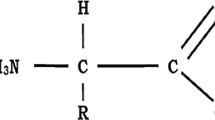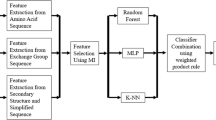Abstract
A Cascade Correlation Learning Architecture (CCLA) of neural networks is tested on the task of predicting the secondary structure of proteins. The results are compared with those obtained with Neural Networks (NN) trained with the back-propagation algorithm (BPNN) and generated with genetic algorithms. CCLA proceeds towards the global minimum of the error function more efficiently than BPNN. However, only a slight improvement in the average efficiency value is noticeable (61.82% as compared with 61.61% obtained with BPNN). The values of the three correlation coefficients for the discriminated secondary structures are also rather similar (Ct8,C α ,C β and Ccoil are 0.36, 0.29 and 0.36 with CCLA, and 0.36, 0.31 and 0.35 with BPNN). This indicates that the efficiency of the prediction does not depend upon the training algorithm, and confirms our previous observation that when single sequences are used as input code to the network system, different NN architectures can perform similarly.
Similar content being viewed by others
References
Qian N, Sejnowski TG. Predicting the secondary structure of globular proteins using neural network models. J Mol Biol 1988; 202: 865–884
Hirst JD, Sternberg JE. Prediction of structural and functional features of proteins and nucleic acid sequences by artificial neural networks. Biochemistry 1992; 31: 7211–7218
Presnell SR, Cohen FE. Artificial neural networks for pattern recognition in biochemical sequences. Ann Rev Biophys Biomol Struct 1993; 22: 283–298
Rumelhart DE, Hinton GE, Williams RJ. Learning representation by backpropagation errors. Nature 1986; 323: 533–536
Holley HL, Karplus M. Protein secondary structure prediction with a neural network. Proc Nat Acad Sci USA 1989; 86: 152–156
Pascarella S, Bossa F. PRONET: a microcomputer program for predicting the secondary structure of proteins with a neural network. Comput Aplic Biosci 1989, 5: 319–320
Kneller DG, Cohen FE, Langridge R. Improvements in protein secondary structure prediction by an enhanced neural network. J Mol Biol 1990; 214: 171–182
Muskal SM, Kim SH. Predicting protein secondary structure content. A tandem neural network approach. J Mol Biol 1992; 225: 713–727
Stolorz P, Lapedes A, Xia Y. Predicting protein secondary structure using neural net and statistical methods. J Mol Biol 1992; 225: 363–377
Fariselli P, Compiani M, Casadio R. Predicting secondary structures of membrane proteins with neural networks. Europ Biophys J 1993, 22: 41–51
Compiani M, Fariselli P, Casadio R. Statistical behaviour of perceptrons: the case study of the prediction of protein secondary structures. Int J Neur Sys 1995 (Supp), 6: 195–199
Rost B, Sander C. Prediction protein secondary structure at better than 70% accuracy. J Mol Biol 1993; 232: 584–599
Rost B, Sander C, Schneider R. Redefining the goals of protein secondary structure prediction. J Mol Biol 1994; 235: 13–26
Rost B, Sander C, Schneider R. PHD: an automatic mail server for protein secondary structure prediction. Comput Applic Biosci 1994; 10: 53–60
Vivarelli F, Giusti G, Villani M, Campanini R, Fariselli P, Compiani M, Casadio R. LGANN: a parallel system combining a local genetic algorithm and neural networks for the prediction of secondary structure of proteins. Comput Applic Biosci 1995; 11: 253–260
Haykin S. Neural Networks. A comprehensive foundation. MacMillan College Pub. Co., New York, 1994
Fahlman SE, Lebiere C. The Cascade-correlation learning architecture. Technical Report CMU CS 90-100, Carnegie Mellon University, 1990
Bishop C. Extract calculation of the hessian matrix for the multilayer perceptron. Neural Computation 1992; 4: 494–501
Fahlman SE. Faster learning variations on back-propagation: an empirical study. Proc 1988 Connectionist Models Summer School, Morgan Kaufmann, 1988
Bernstein FC, Koetzle TF, Williams GJB, Meyer EF, Brice MD, Rodgers JR, Kennard O, Shimanouchi T, Tasumi M. The protein data bank: a computer-based archival file for macromolecular structure. J Mol Biol 1977; 112: 535–542
Lipman DJ, Pearson WR. Rapid and sensitive protein similarity searches. Science 1985; 227: 1435–1441
Kabsch W, Sander C. Dictionary of protein secondary structure. Pattern of hydrogen-bonded and geometrical features. Biopolymers 1983; 22: 2577–2673
Schulz GE, Schirmer RH. Principles of Protein Structure. Springer-Verlag, Berlin, 1979
Matthews BW. Comparison of the predicted and observed secondary structure of T4 phage lysozyme. Biochim Biophys Acta 1975; 405: 442–451
Author information
Authors and Affiliations
Rights and permissions
About this article
Cite this article
Vivarelli, F., Fariselli, P. & Casadio, R. The prediction of protein secondary structure with a Cascade Correlation Learning Architecture of neural networks. Neural Comput & Applic 6, 57–62 (1997). https://doi.org/10.1007/BF01670152
Issue Date:
DOI: https://doi.org/10.1007/BF01670152




